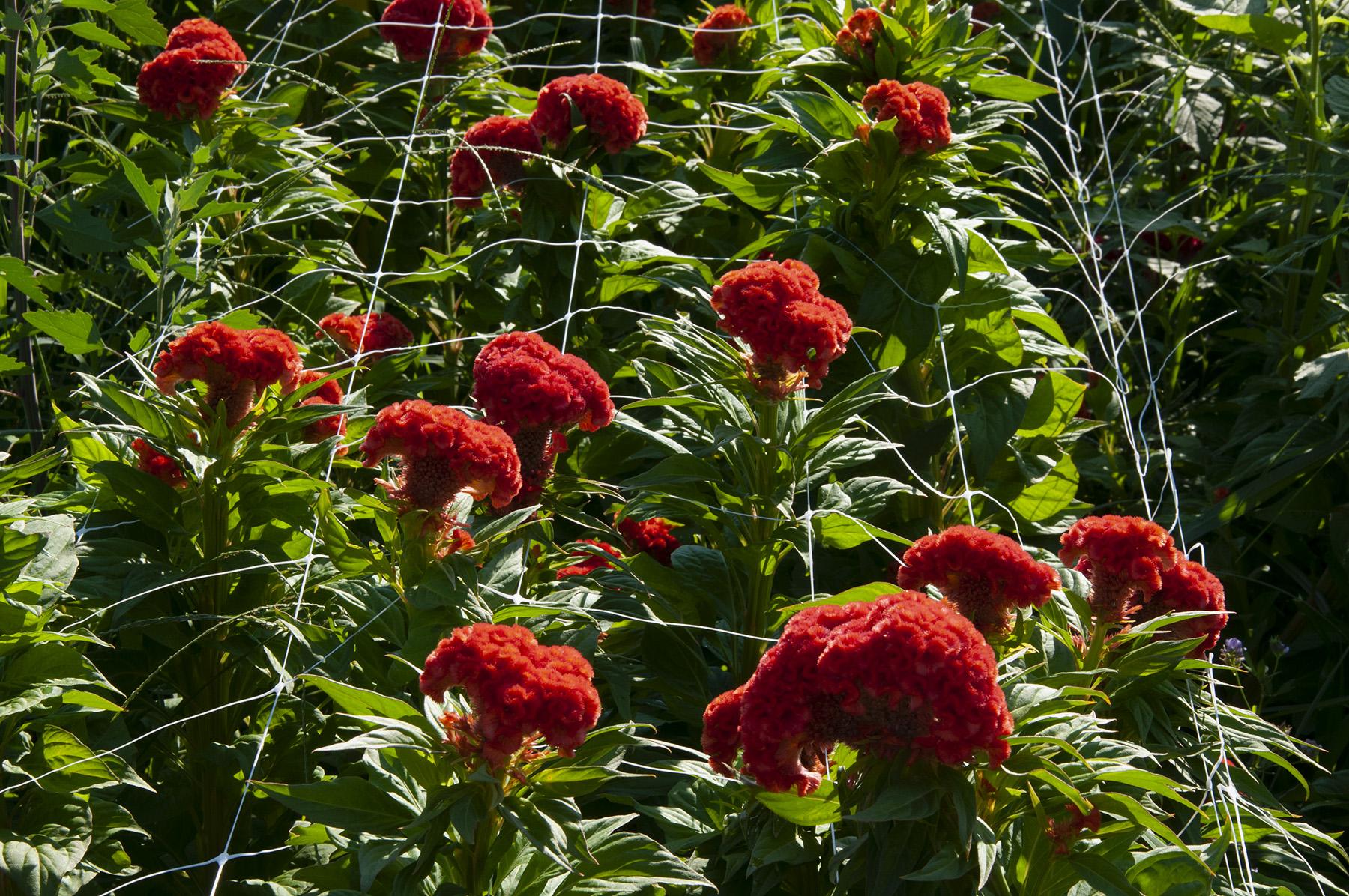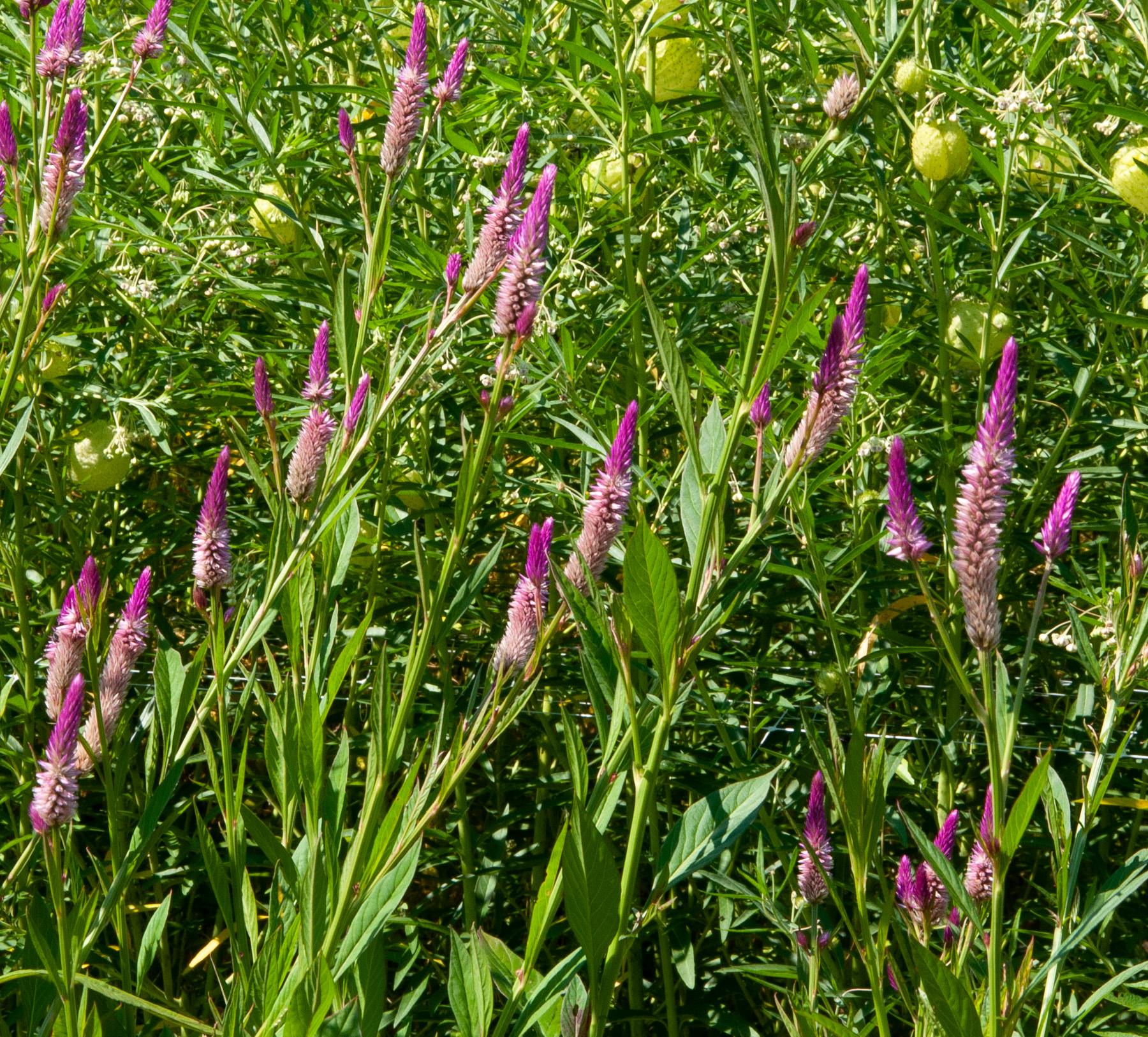Propagation
Celosia is propagated from seed (43,000 seeds/ounce). Many cut-flower growers collect seed for future production. Some crested- and wheat-type varieties will reliably give back the characteristics of the parent plants when grown from seed, but many plume types will produce unpredictable shapes and colors.
Celosia seed is extremely small, and seedlings are vulnerable to damping-off. Celosia grows best when started in market packs or in trays in a greenhouse. However, Celosia seedling roots are sensitive to transplanting. If you start seeds indoors, plant them in individual cells or pots, not in flats. Sow Celosia 4 weeks before the last frost date. Seed does not require light to germinate but must be lighted shortly after germinating to prevent plant stretching.
Care is needed to keep Celosia seed from drying out. Lightly cover seed and place it under mist for 10 to 14 days until it germinates. Germinate Celosia seed at 65 to 70 °F at night and at 80 to 85 °F during the day. Exposure to temperatures below 60 °F will stunt plants and cause premature flowering.
Some growers plant Celosia directly into prepared field beds. Sow or transplant Celosia in the field after the danger of frost has passed. In general, field planted Celosia seed and weed seed germinate at the same time and create an undesirable, competitive environment. A plant started in the greenhouse and transplanted to the field has a head start in competing with weeds.
Transplanting
Transplant Celosia to the field when night (field) temperatures are consistently above 65 to 70 °F and plants are in the 2- to-4-leaf stage, approximately 4 weeks after sowing. Do not hold plants in market packs or other growing containers. Once seedlings are potbound, they have been stunted and will never develop into full-sized plants. If they have been severely stunted, celosias will bloom prematurely with small flower heads and short stems. After transplanting seedlings, make sure they receive one inch of water each week from either irrigation on rain. Although Celosia is heat and drought tolerant, lack of steady moisture can stunt plants and promote premature flowering.
Spacing in the field depends on the type selected and whether single-stem or pinched-production is the management choice. Crested types need at least 18 inches between plant centers. Plume types should have at least 24 inches between plants. Wheat types should be planted 24 to 36 inches apart. Spacing can also affect the final flower size. Spacing on 6-inch centers is necessary to produce plants with small heads, which may be desirable in some markets.
Field Production
Celosia thrives in well-drained soil with a pH of 6.0 to 6.4. For cut flower field production, pick a location with a rich, deep, loamy soil and at least 8 hours of sunlight. Plants with too little sun will be leggy and will not produce marketable flowers. Celosia normally requires 4 to 12 weeks of vegetative growth prior to flower initiation for optimum shoot development.
To obtain the maximum number of multiple flower heads for crested- and plume-type Celosias, pinch plants 2 weeks after transplanting. This will promote branching and multiple, small flower heads. If you have a market for large, crested Celosia flower heads, do not pinch the first bloom. Some of the crested types may require staking to keep flower heads from falling over. Wheat and many plume-type celosias are free branching and do not require pinching.
Celosia plants need relatively high amounts of nutrients; nitrogen is the key element. Select fertilizers with a 3-1-2 ratio of nutrients. Run a soil test and bring up fertility levels according to Maryland nutrient management regulations before planting Celosia. After planting, maintain high fertility levels to promote growth.
Greenhouse Production
Celosia can be produced in green houses from spring through summer. The vegetative growth of greenhouse Celosia benefits from high humidity and 3,500 to 5,000-foot candles of light. For plant approaching harvest, shade and less humidity improve the postharvest quality.
Nutrition: Greenhouse Celosia needs weekly applications of a dilute complete fertilizer (for example, 20-10-20 or 15-5-15) at 100 to 150 ppm based on nitrogen.
Temperature: Once Celosia plants are established, warm temperatures (80 °F) will promote flowering better than cool temperatures (below 50 °F). Because Celosia exhibits a strong response to temperature, sequential plantings can extend the period of harvest.
Photoperiod: Celosia is a quantitative short-day plant. Although it will flower at any photoperiod, one of 14 hours or less is best. For the fastest flowering, 4 to 5 weeks of short days are needed. After 4 weeks, there is no delay in the rate of flowering or reduction in flower quality if Celosia receives a long-day photoperiod. Long days promote increased fasciation in crested types.
Season of Bloom: Celosia blooms from midsummer to fall and produces harvestable flowers for up to 8 weeks. Sequential planting (every 2 to 4 weeks) of crested or plume types will ensure a constant supply of large flower spikes.
Harvesting: Harvest crested Celosia when the center of the head has expanded but before outer edges begin to discolor. Plume- and wheat-type celosias should be harvested when 50 percent of their flowers are open. Late harvest of flower heads will allow the development of seed that will shatter in the consumer's environment. Cut Celosia so that two or three leaves remain on the stem. The leaves help pull water up the stem, which helps retain freshness. Secondary flowers can be used for potpourri or crafts.
Drying Celosia for Everlasting Sales: Crested- and plume-type celosias are well suited to drying and selling as ever lasting cut flowers. Wheat-type Celosia has a tendency to shatter when dried, making it difficult to handle or ship without damaging the flower head. The wheat Celosia 'Flamingo Feather' dries to a snowy white. 'Flamingo Purple' and 'Tassles Deep Rose' retain their color fairly well when dried.
For the best color retention, all celosias should be dried rapidly. Some growers utilize a greenhouse covered with black plastic, place harvested stems on a bench, and use exhaust fans to carry out moisture. This is done for 7 to 14 days.
Summary
• Select Celosia types and colors according to your market needs.
• When starting seedlings in containers, keep the plants growing vigorously. Do not allow the
plants to become stressed because this may cause premature flowering.
• Grow plants in full sun.
• If you desire multiple flower heads, pinch plume and crested types when the first flower forms.
• Monitor for aphids and beneficial insects.
• Monitor for diseased plants and promptly remove those that are infected.






